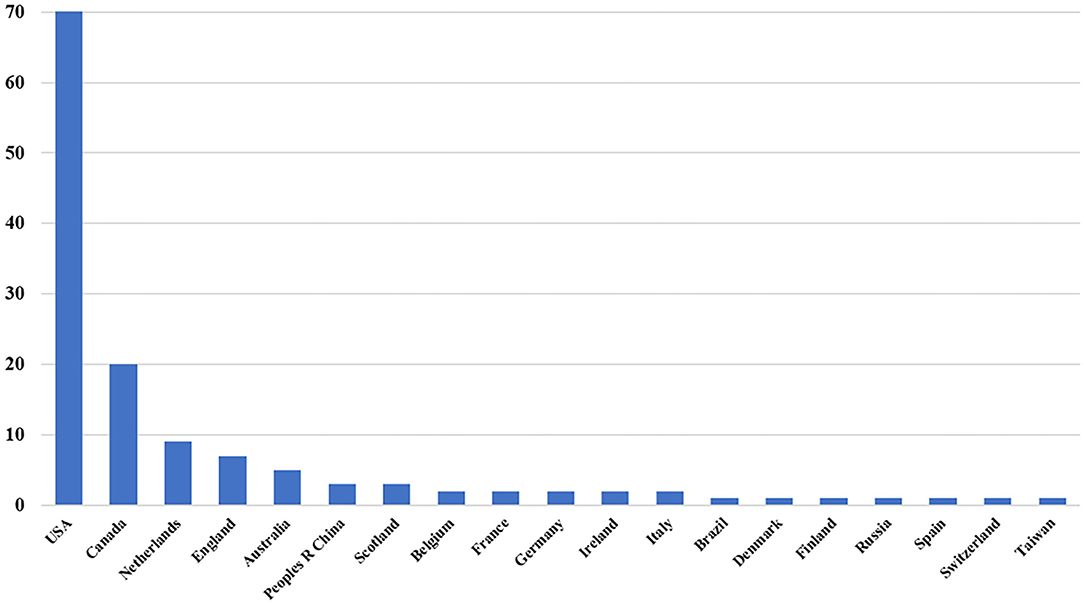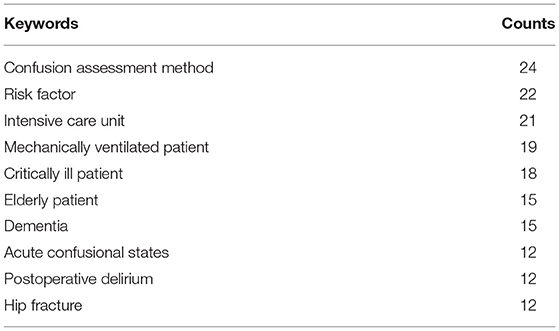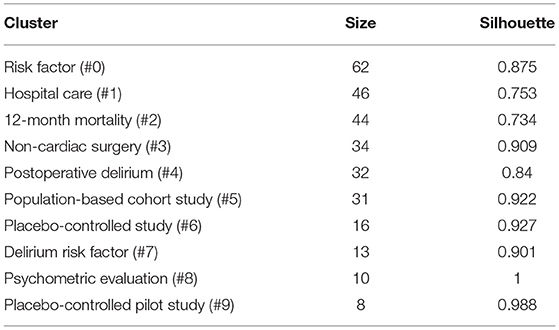- 1Department of Psychiatry Chengdu Eighth People's Hospital (Geriatric Hospital of Chengdu Medical College), Chengdu, China
- 2Department of Rehabilitation Medicine, The Affiliated Hospital of Southwest Medical University, Luzhou, China
- 3Department of Rehabilitation Medicine, The First Affiliated Hospital of Chengdu Medical College, Chengdu, China
Delirium is a cognitive disorder with complex etiology, which brings a great burden to social health care. Articles with high citation frequency can provide important information about the current research situation in a certain field. Web of Science was used to search the 100 most-cited articles and we extracted key information, such as the authors, countries/regions, institutions, journals, and study types of these articles. CiteSpace was used to visually analyze the keywords. Our bibliometric analysis shows that the attention in this field continues to rise. Authors from the United States published the most articles and Inouye SK is the most influential author in the field. The journals that published these articles have high impact factors. Cohort studies are the main cited articles in this field, and there are a large number of systematic reviews or meta-analyses of cohort studies. Risk factors for delirium, psychometric evaluation, hospital care, and various clinical study design are still the focus of research. In short, we summarized the 100 most-cited articles in the field of delirium to identify the current status and global trends. These results enable researchers to understand the quality and trend of research in the field of delirium and make better use of the classical literature.
Introduction
Delirium is a non-specific, preventable, and reversible cognitive disorder characterized by acute changes in mental state, inattention, and confusion of thinking (1). The cause of delirium is complicated, which is often caused by various promoting factors on the basis of risk factors, such as advanced age and cardiopulmonary dysfunction (2, 3). The incidence and prevalence rate varies greatly according to the clinical situation and population (4). The occurrence of delirium can not only lead to longer hospital stays and increased medical expenses but also affect the long-term cognitive ability of patients without timely treatment (5, 6). Therefore, early identification of the causes of delirium and correction of risk factors can improve the symptoms of delirium and reduce the burden on society and family (7).
Bibliometric analysis is an important tool to evaluate research performance and identify influential papers in specific fields (8). Articles with high citation frequency can provide important information about the current research situation in a certain field (9). At present, a large number of studies on delirium have been published, including bibliometric analysis in the field of delirium within a certain time frame (10, 11). However, bibliometric analyses of articles with high quality and high citation frequency of delirium have not been reported. Considering the clinical significance of delirium and the importance of highly cited articles, we qualitatively and quantitatively analyzed the 100 most-cited articles in the field of delirium, in order to help researchers to understand the research quality and trends, better use of the classical articles about delirium, and provide a reference for future research in this field.
Methods
Database Selection and Search Strategy
Scopus and Web of Science are popular bibliometrics search tools, but Scopus only includes articles published after 1966 (12). Considering that classical articles may be published earlier, we used the Web of Science core collection (index: Science Citation Index Expanded) as the search tool and TI= “delirium” as the search strategy to get the research in the field of delirium on 18 April 2022.
Data Collection and Analysis
Two researchers sorted the citation frequency of the searched articles from high to low and downloaded the data of top-100 articles for further analysis. Key information, such as author, institution, title, publication year, citation frequency, citation density (total citation frequency divided by the year since publication), journal name, impact factor (IF), and country/region, were extracted.
CiteSpace is a visualization analysis software developed gradually under the background of bibliometrics and data visualization (13). Now it has updated several versions, and the data visualization function is more and more powerful (13). In this study, the CiteSpaceV 5.8.R3 software was used for keywords co-occurrence analysis and cluster analysis (the original data of the 100 most-cited articles has been uploaded to Data Sheet 1). Specific parameters were set according to previous studies as follows (14, 15): “Time Slicing” was set to 1955–2022 (#Years Per Slice = 1); “Term Source” selected “Title,” “Abstract,” “Author Keywords (DE),” and “Keywords Plus (ID)”; “Node Types” selected to “Keywords”; “Links” and “Selection Criteria” used the default option; “Pruning” selected “pathfinder” and “pruning the merged network”; “Visualization” selected “cluster view-static” and “show merged network.”
In addition, some journals changed their names, such as Archives of Internal Medicine to JAMA Internal Medicine. We used the original journal name in the results section and reported the IFs in 2020. Two researchers completed the above process independently. If there was a disagreement between the two researchers, a third researcher would intervene. No patient or public participation in this study, so no ethical approval was required to conduct this study.
Results
Publications and Citations
The top-100 articles about delirium searched are shown in Supplementary Table S1. These articles were published between 1955 and 2018, with the largest number of articles published in 2001 (n = 10). The publication of the articles stabilized as a whole after the tipping point of 2001 (Figure 1A). For the citations, the total annual citations of the article increased steadily from 1984 to 2021. Since 2016, there have been more than 3,000 citations per year (Figure 1B).
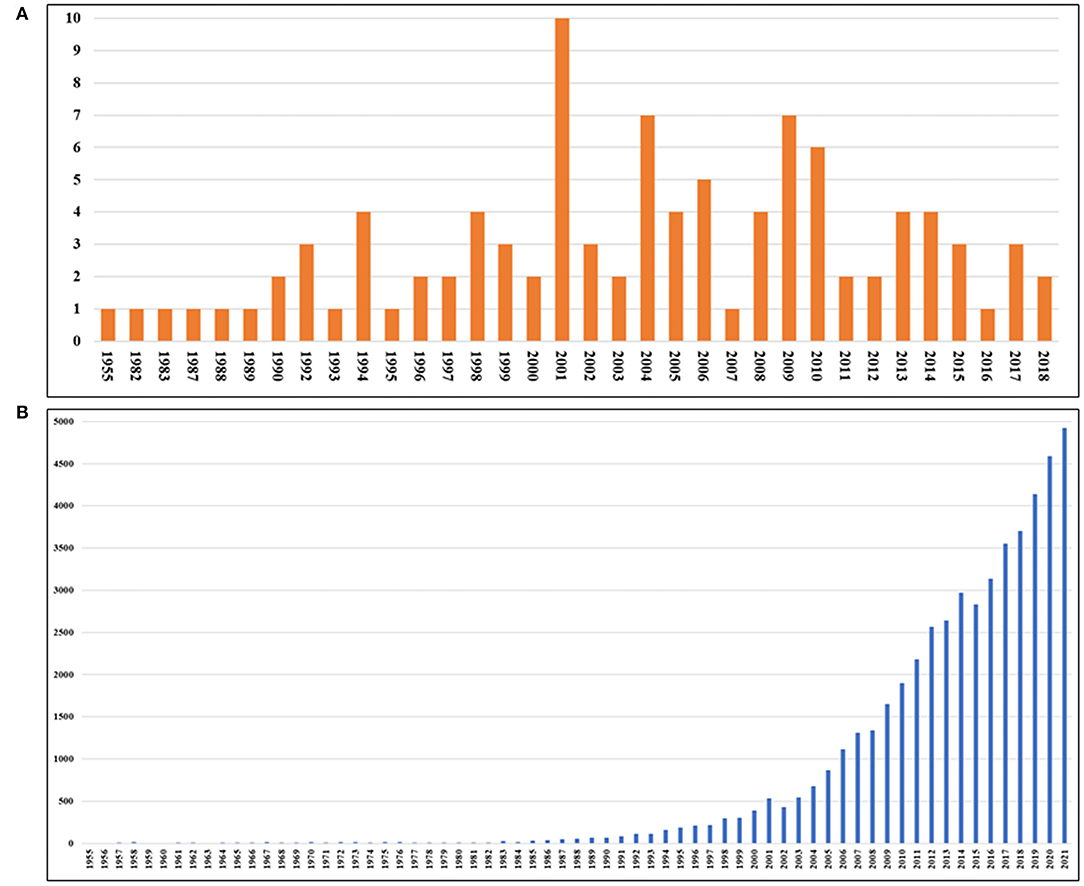
Figure 1. The year of publication (A) and total citation frequency each year of all articles (B) of the 100 most-cited articles in the field of delirium.
Countries/Regions, Institutions, and Authors
The country/region distribution of these papers was analyzed. Authors from the United States published the most papers (n = 72), followed by Canada (n = 20), Netherlands (n = 9), England (n = 7), and Australia (n = 5). Overall, 19 countries/regions account for the top-100 articles in the field (Figure 2). In addition, we counted the top 10 institutions that published these 100 articles (Table 1). Harvard University published 22 articles, followed by Yale University (n = 20), and Vanderbilt University (n = 19), which were also institutions with a citation frequency of more than 10,000. Table 2 shows the top 10 authors who have published the most top papers. The author with the most articles was Inouye SK, with a total of 26, and 11 were published as the first author. The total number and average of citations of his articles were also the highest (19,942 and 771.85). Ely EW (n = 16), Marcantonio ER (n = 13), Bernard GR (n = 8), and Pun BT (n = 8) ranked second to fifth, respectively.
Journals
The articles were published in 36 journals. The top 10 cited journals, IFs, and Journal Citation Reports (JCR) area are shown in Table 3. According to the JCR zoning, all journals belong to the Q1 zone. Among these journals, the most citation frequency was Critical Care Medicine (n = 12), followed by Journal of the American Geriatrics Society (n = 11), and JAMA-Journal of the American Medical Association (n = 10). And New England Journal of Medicine had the highest IF of 91.245. In addition, the IF of 9 journals was more than 5.
Study Types
There were no animal or cell experiments in these articles. There were 99 clinical-related articles, and only one was about the delirium hypothetical model (Figure 3A). Since most of the articles were clinical-related articles, we further classified the clinical evidence levels of this kind of study (Figure 3B). In these articles, more than half of the highly cited articles were cohort studies with clinical evidence level II (b) (n = 58). Randomized controlled trials (RCTs) with clinical evidence grade I (b) accounted for 10% (n = 10), and expert opinions, systematic reviews, meta-analysis, and other summary studies accounted for 30% (n = 30).
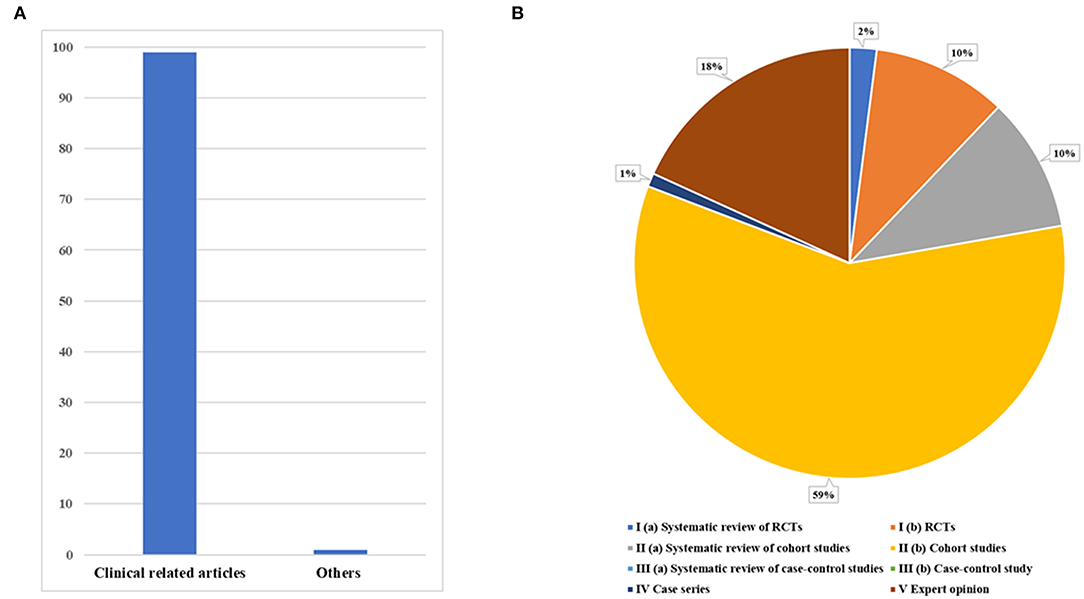
Figure 3. Study types of the 100 most-cited articles in the field of delirium. (A) The article classification. (B) The level of evidence for clinically relevant articles.
Keywords
We conducted a visual analysis of keywords in the top-100 articles by CiteSpace (Figure 4). Both keywords co-occurrence analysis and cluster analysis can be displayed in visual maps. Each node represents a keyword, and the node size represents the frequency of the keyword. That is to say, the larger the node is, the more frequently the keyword appears, which can indicate that the keyword may be the focus or hotspot of this research field. Besides, there will be a line connecting two nodes if they appear in one article at the same time, which means the two keywords have a co-occurrence relationship. The thicker the connection line is, the higher the co-occurrence frequency of the two keywords, which indicates that there may be a close relationship between them (16).
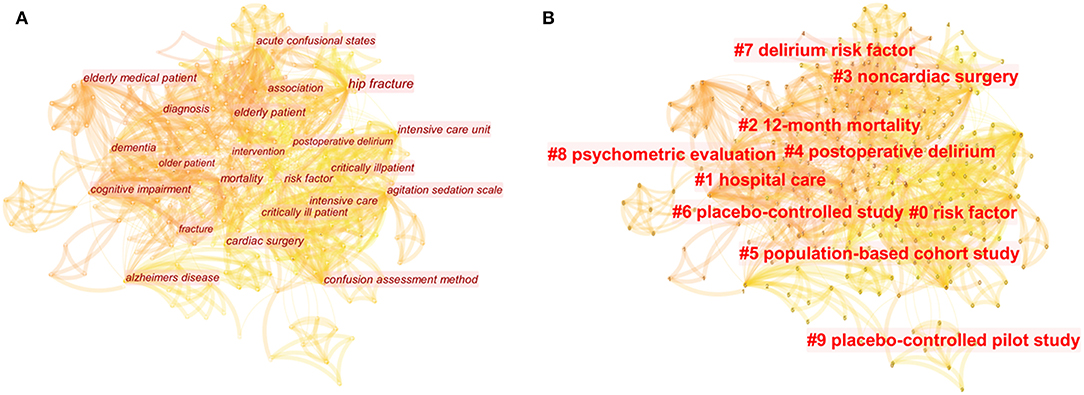
Figure 4. Keyword visualization analysis of the 100 most-cited articles in the field of delirium. (A) The map of keywords co-occurrence analysis. (B) The map of keywords cluster analysis.
In total, the keyword co-occurrence analysis generated 298 nodes and 1,367 links (Figure 4A). The top-10 keywords with the highest frequency of co-occurrence were “confusion assessment method,” “risk factor,” “intensive care unit,” “mechanically ventilated patient,” “critically ill patient,” “elderly patient,” “dementia,” “acute confusional states,” “postoperative delirium,” and “hip fracture” (Table 4).
Cluster analysis divided these keywords into 10 clusters, namely “risk factor” (#0), “hospital care” (#1), “12-month mortality” (#2), “non-cardiac surgery” (#3), and “postoperative delirium” (#4), “population-based cohort study” (#5), “placebo-controlled study” (#6), “delirium risk factor” (#7), “psychometric evaluation” (#8), and “placebo-controlled pilot study” (#9) (Figure 4B). The value of Q and Silhouette in CiteSpace are often used to determine whether clustering is reliable. In general, the Q value is >0.3 and the silhouette value is >0.7, which indicates that the clustering is reliable and worthy of attention. Our cluster analysis results show that the value of Q was 0.5827, and the silhouette values of all clusters were >0.70 (Table 5).
Discussion
The total number of citations for a published article indicates the importance of the published article in this practical field, and the analysis of the most influential publications is helpful to identify research hotspots in a particular field (9). In this study, we identified the 100 most-cited articles in the field of delirium and analyzed their related bibliometric indicators, study types, and keywords.
The results of publications and citations suggest that the overall publication of articles tends to be stable, and the number of citations is increasing year by year, indicating that the attention of this field continues to rise. The most-cited article is “Clarifying confusion: the confusion assessment method. A new method for detection of delirium” published by Inouye SK et al. in 1990 (17). They developed and validated a new standardized disorder assessment method (CAM) that allows non-psychiatric clinicians to quickly detect delirium in high-risk environments. Even today, CAM or its improved version is still used clinically, which is of great historical significance (18). It is worth mentioning that more than 1/5 of the 100 most-cited articles have his contribution, which means that Inouye SK is the most influential author in the field.
In addition, these articles were published between 1955 and 2018, while the total citation frequency of articles published in the last 3 years did not enter the top-100. This suggests that recently published papers need a period of exposure time to increase citation. Therefore, we introduce the definition of citation density so as not to miss the article which is published later but of great significance (19). We found that the article with the highest citation density is “Clinical practice guidelines for the management of pain, agitation, and delirium in adult patients in the intensive care unit” published by Barr Juliana et al. in 2013. This article provides an effective guide for the prevention and treatment of delirium in critically- ill patients (20).
We analyzed the countries/regions and institutions' distribution of these publications and found that the United States had the largest number of publications, followed by Canada. The total number of articles published in these two countries is more than 90% of the top-100 articles. Harvard University, Yale University, and Vanderbilt University in the United States are the top three institutions that publish the most top articles, accounting for more than half of the most-cited articles. This suggests that the United States is still at the forefront of the world in the field of delirium.
Journal analysis enables researchers to understand the journal distribution of the articles, which is helpful for researchers to choose journals in the field of delirium and to evaluate the overall quality of articles. Most articles have been published in Critical Care Medicine, and some articles have been published in top journals, such as JAMA-Journal of the American Medical Association and New England Journal of Medicine. And journals with high IF and in high JCR areas usually have high academic influence and attract more high-quality papers. We found that the journals that publish these articles are of high quality, almost all journals have high IFs, and most of the articles belong to the JCR Q1. These results indicate that the field of delirium is very mature and has attracted much attention from researchers.
In addition, most of these articles are clinical-related studies, which indirectly indicates that delirium is of high clinical concern at present, which may be related to its clinical incidence. In previous studies, review papers were usually cited the most frequently (21). However, our study found that cohort studies are the main cited articles in this field, and there are a large number of systematic reviews or meta-analyses of cohort studies. In order to evaluate the assessment of delirium and predict its risk factors, a cohort study is a more appropriate method, which we think is the reason for the large number of articles cited in this type of article (22, 23). There is only one non-clinically relevant article, which introduces a hypothetical model of delirium that suggests that drugs that restore microglial choline to control or directly inhibit neuroinflammation need clinical trials (24). Although this article can not be classified by the existing methods of classification of clinical evidence, it still provides ideas for clinical workers to guide the use of drugs and carry out therapeutic clinical trials.
Finally, we use visualization software to analyze the keywords of these articles, which is conducive to a further understanding of the various sub-directions involved. Keyword co-occurrence analysis can show the relationship between the main keywords, and cluster analysis is to classify keywords and group some keywords with the same attributes. Keyword co-occurrence analysis and cluster analysis of the top-100 articles can help readers sort out the hot areas of popular literature research and current research trends (8, 25). The results suggest that the research direction in the field of delirium focuses on the evaluation and treatment of delirium in critically ill patients and postoperative delirium (1, 26, 27). Furthermore, “confusion assessment method” and “risk factor” co-occur frequently, which is not surprising to us. Because if delirium can be effectively identified and prevented, the subsequent damage caused by the disease to patients can be reduced, and the key to effective prevention of delirium is to evaluate the risk factors (20). Cluster analysis is better to classify the related keywords into one category. Through cluster analysis, we find that risk factors for delirium, psychometric evaluation, hospital care, and various clinical study design are also hot topics in this field (28–30).
Limitations
Our study has some limitations. The articles with the highest frequency of citation are those that have been published for a long time, which makes some newly published high-quality papers can not be cited enough to be analyzed by us (31). Furthermore, the keywords used in this study may not cover all the literature in this field, which is also an inherent limitation of bibliometrics (32). In addition, due to the time gap between the inclusion of the Web of Science and the publication of articles, some publications have not been included until 2022, and the citation times of articles are different when searching at different time points, so it is necessary to update them in future research.
Conclusion
We summarized the 100 most-cited articles in the field of delirium to identify the current status and global trends. Our bibliometric analysis shows that the attention in this field continues to rise. The United States is still at the forefront of the world in this field. And researchers may prefer to cite the results of cohort studies. In addition, our results provide support for future research. Risk factors for delirium, psychometric evaluation, hospital care, and various clinical study design are still the focus of research.
Data Availability Statement
The original contributions presented in the study are included in the article/Supplementary Material, further inquiries can be directed to the corresponding author.
Ethics Statement
The study was exempted from institutional ethics review because only publicly available data were analyzed.
Author Contributions
YG and FX: concept and design, administrative, technical, or material support. XF, QZ, and JW: acquisition, analysis, or interpretation of data. XF, QZ, and YG: critical revision of the manuscript for important intellectual content. XF and JW: statistical analysis. FX: supervision. All authors: drafting of the manuscript. All authors contributed to the article and approved the submitted version.
Funding
This work was supported by the Special Scientific Research Project of Venous Thromboembolism Prevention (Heng Rui) of Sichuan Medical Association (Grant Number: 2019HR12), Special Support (Cultivation) Project Southwest Medical University (2022–2024), 2021 Sichuan Provincial Cadre Health Project (Grant Number: 2021-1505), and Cooperation Project of Luzhou Science and Technology Bureau and Southwest Medical University (Grant Number: 2019LZXNYDJ40).
Conflict of Interest
The authors declare that the research was conducted in the absence of any commercial or financial relationships that could be construed as a potential conflict of interest.
Publisher's Note
All claims expressed in this article are solely those of the authors and do not necessarily represent those of their affiliated organizations, or those of the publisher, the editors and the reviewers. Any product that may be evaluated in this article, or claim that may be made by its manufacturer, is not guaranteed or endorsed by the publisher.
Supplementary Material
The Supplementary Material for this article can be found online at: https://www.frontiersin.org/articles/10.3389/fpsyt.2022.931632/full#supplementary-material
References
1. Oh ES, Fong TG, Hshieh TT, Inouye SK. Delirium in older persons: advances in diagnosis and treatment. JAMA. (2017) 318:1161–74. doi: 10.1001/jama.2017.12067
2. Kong D, Luo W, Zhu Z, Sun S, Zhu J. Factors associated with post-operative delirium in hip fracture patients: what should we care. Eur J Med Res. (2022) 27:40. doi: 10.1186/s40001-022-00660-9
3. Geyskens L, Jeuris A, Deschodt M, Van Grootven B, Gielen E, Flamaing J. Patient-related risk factors for in-hospital functional decline in older adults: A systematic review and meta-analysis. Age Ageing. (2022) 51:afac007. doi: 10.1093/ageing/afac007
4. McCoy TH Jr, Hart KL, Perlis RH. Characterizing and predicting rates of delirium across general hospital settings. General Hospital Psychiatry. (2017) 46:1–6. doi: 10.1016/j.genhosppsych.2017.01.006
5. Liu B, Huang D, Guo Y, Sun X, Chen C, Zhai X, et al. Recent advances and perspectives of postoperative neurological disorders in the elderly surgical patients. CNS Neurosci Ther. (2022) 28:470–83. doi: 10.1111/cns.13763
6. Van Rompaey B, Van Hoof A, van Bogaert P, Timmermans O, Dilles T. The patient's perception of a delirium: a qualitative research in a Belgian intensive care unit. Intensive Crit Care Nurs. (2016) 32:66–74. doi: 10.1016/j.iccn.2015.03.002
7. Androsova G, Krause R, Winterer G, Schneider R. Biomarkers of postoperative delirium and cognitive dysfunction. Front Aging Neurosci. (2015) 7:112. doi: 10.3389/fnagi.2015.00112
8. Wang SQ, Wang JX, Zhang C, Sun FH, Xie YJ, Jiang W, et al. What you should know about osteoarthritis rehabilitation: a bibliometric analysis of the 50 most-cited articles. Geriatr Orthop Surg Rehabil. (2020) 11:2151459320973196. doi: 10.1177/2151459320973196
9. Yi K, Xu JG, Yang KL, Zhang X, Ma L, You T, et al. The top-100 most cited articles of biomarkers in congenital heart disease: a bibliometric analysis. Ann Palliat Med. (2021) 11:1700–13. doi: 10.21037/apm-21-2422
10. Grover S, Gupta BM. A scientometric study of publications on delirium from 2001 to 2020. Asian J Psychiatr. (2021) 66:102889. doi: 10.1016/j.ajp.2021.102889
11. McCoy TH Jr. Mapping the delirium literature through probabilistic topic modeling and network analysis: a computational scoping review. Psychosomatics. (2019) 60:105–20. doi: 10.1016/j.psym.2018.12.003
12. Falagas ME, Pitsouni EI, Malietzis GA, Pappas G. Comparison of PubMed, Scopus, Web of Science, and Google Scholar: strengths and weaknesses. FASEB J. (2008) 22:338–42. doi: 10.1096/fj.07-9492LSF
13. Chen C, Hu Z, Liu S, Tseng H. Emerging trends in regenerative medicine: a scientometric analysis in CiteSpace. Expert Opin Biol Ther. (2012) 12:593–608. doi: 10.1517/14712598.2012.674507
14. Wang SQ, Gao YQ, Zhang C, Xie YJ, Wang JX, Xu FY, et al. Bibliometric Analysis Using CiteSpace of Publications from 1999 to 2018 on patient rehabilitation after total knee arthroplasty. Med Sci Monit. (2020) 26:e920795. doi: 10.12659/MSM.920795
15. Liu X, Liu N, Zhou M, Lu Y, Li F. Bibliometric analysis of global research on the rehabilitation of spinal cord injury in the past two decades. Ther Clin Risk Manag. (2019) 15:1–14. doi: 10.2147/TCRM.S163881
16. Chen C. Searching for intellectual turning points: progressive knowledge domain visualization. Proc Natl Acad Sci U S A. (2004) 101 (Suppl 1):5303–10. doi: 10.1073/pnas.0307513100
17. Inouye SK, van Dyck CH, Alessi CA, Balkin S, Siegal AP, Horwitz RI. Clarifying confusion: the confusion assessment method. A new method for detection of delirium. Ann Intern Med. (1990) 113:941–8. doi: 10.7326/0003-4819-113-12-941
18. Leslie DL, Fick DM, Moore A, Inouye SK, Jung Y, Ngo LH, et al. Comparative salary-related costs of a brief app-directed delirium identification protocol by hospitalists, nurses, and nursing assistants. J Am Geriatr Soc. (2022) 1–8. doi: 10.1111/jgs.17789
19. Franceschini M, Boffa A, Andriolo L, Di Martino A, Zaffagnini S, Filardo G. The 50 most-cited clinical articles in cartilage surgery research: a bibliometric analysis. Knee Surg Sports Traumatol Arthrosc. (2022) 30:1901–14. doi: 10.1007/s00167-021-06834-y
20. Barr J, Fraser GL, Puntillo K, Ely EW, Gélinas C, Dasta JF, et al. Clinical practice guidelines for the management of pain, agitation, and delirium in adult patients in the intensive care unit. Crit Care Med. (2013) 41:263–306. doi: 10.1097/CCM.0b013e3182783b72
21. Baltussen A, Kindler CH. Citation classics in critical care medicine. Intensive Care Med. (2004) 30:902–10. doi: 10.1007/s00134-004-2195-7
22. Mossie A, Regasa T, Neme D, Awoke Z, Zemedkun A, Hailu S. Evidence-based guideline on management of postoperative delirium in older people for low resource setting: systematic review article. Int J Gen Med. (2022) 15:4053–65. doi: 10.2147/IJGM.S349232
23. Neme D, Aweke Z, Micho H, Mola S, Jemal B, Regasa T. Evidence-based guideline for adult sedation, pain assessment, and analgesia in a low resource setting intensive care unit: review Article. Int J Gen Med. (2020) 13:1445–52. doi: 10.2147/IJGM.S276878
24. van Gool WA, van de Beek D, Eikelenboom P. Systemic infection and delirium: when cytokines and acetylcholine collide. Lancet (London, England). (2010) 375:773–5. doi: 10.1016/S0140-6736(09)61158-2
25. Zhu G, Fu Z, Su S, Tang Y, Liu F, Yu W. Global trends and hotspots in trigeminal neuralgia research from 2001 to 2021: a bibliometric analysis. Front Neurol. (2022) 13:894006. doi: 10.3389/fneur.2022.894006
26. Lewis SR, Macey R, Parker MJ, Cook JA, Griffin XL. Arthroplasties for hip fracture in adults. Cochrane Database Syst Rev. (2022) 2:Cd013410. doi: 10.1002/14651858.CD013410.pub2
27. Wilson JE, Mart MF, Cunningham C, Shehabi Y, Girard TD, MacLullich AMJ, et al. Delirium. Nat Rev Disease Prim. (2020) 6:90. doi: 10.1038/s41572-020-00223-4
28. Prendergast NT, Tiberio PJ, Girard TD. Treatment of delirium during critical illness. Annu Rev Med. (2022) 73:407–21. doi: 10.1146/annurev-med-042220-013015
29. Kitsis P, Zisimou T, Gkiatas I, Kostas-Agnantis I, Gelalis I, Korompilias A, et al. Postoperative delirium and postoperative cognitive dysfunction in patients with elective hip or knee arthroplasty: a narrative review of the literature. Life (Basel). (2022) 12:314. doi: 10.3390/life12020314
30. Verbeek T, Adhikary S, Urman R, Liu H. The application of fascia iliaca compartment block for acute pain control of hip fracture and surgery. Curr Pain Headache Rep. (2021) 25:22. doi: 10.1007/s11916-021-00940-9
31. Karsli B, Tekin SB. The top 100 most-cited articles on ankle arthroscopy: bibliometric analysis. J Foot Ankle Surg. (2021) 60:477–81. doi: 10.1053/j.jfas.2020.08.028
Keywords: bibliometric analysis, bibliometrics, delirium, psychiatry, cognitive disorder, top-100
Citation: Fei X, Zeng Q, Wang J, Gao Y and Xu F (2022) Bibliometric Analysis of 100 Most-Cited Articles in Delirium. Front. Psychiatry 13:931632. doi: 10.3389/fpsyt.2022.931632
Received: 29 April 2022; Accepted: 09 June 2022;
Published: 06 July 2022.
Edited by:
Leonardo Baldaçara, Federal University of Tocantins, BrazilReviewed by:
Andy Wai Kan Yeung, University of Hong Kong, ChinaBrazilio De Carvalho Tasso, Trofa Saúde Hospital Gaia, Portugal
Copyright © 2022 Fei, Zeng, Wang, Gao and Xu. This is an open-access article distributed under the terms of the Creative Commons Attribution License (CC BY). The use, distribution or reproduction in other forums is permitted, provided the original author(s) and the copyright owner(s) are credited and that the original publication in this journal is cited, in accordance with accepted academic practice. No use, distribution or reproduction is permitted which does not comply with these terms.
*Correspondence: Yaqian Gao, NjczNTA5MzY2QHFxLmNvbQ==; Fangyuan Xu, eHU1MTQ0QDEyNi5jb20=
†These authors have contributed equally to this work and share senior authorship
 Xinxing Fei
Xinxing Fei Qiu Zeng
Qiu Zeng Jianxiong Wang
Jianxiong Wang Yaqian Gao
Yaqian Gao Fangyuan Xu
Fangyuan Xu